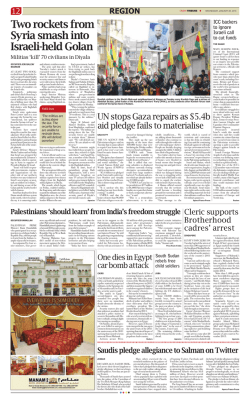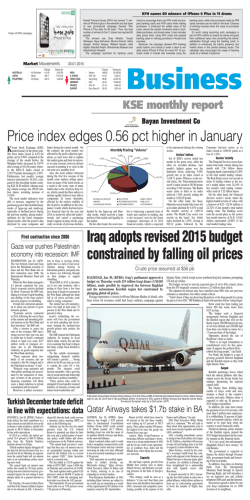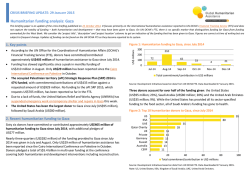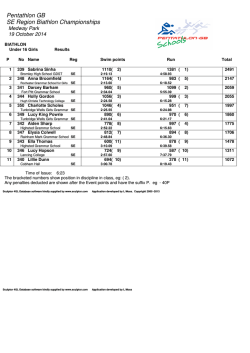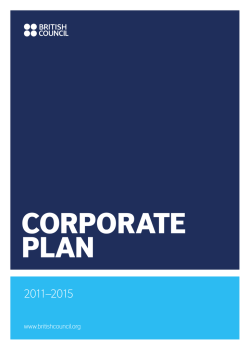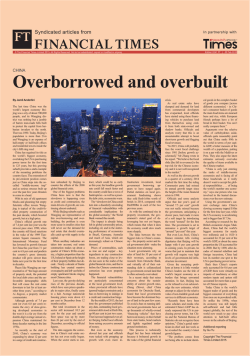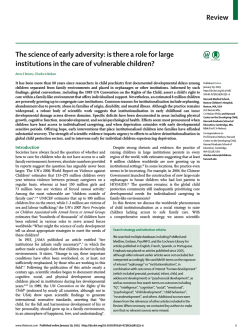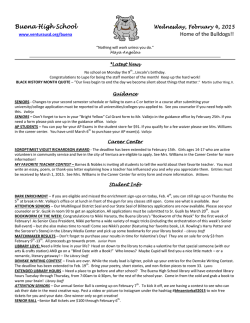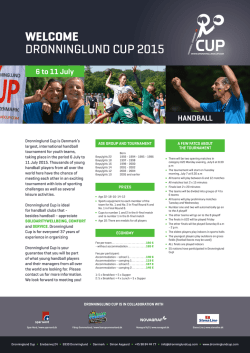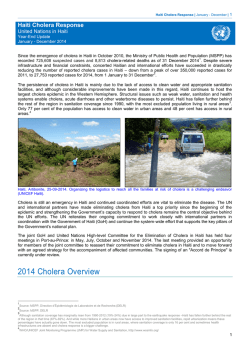
Current appeal [PDF]
2015 © UNICEF/2014/ElBaba Humanitarian Action for Children State of Palestine In Gaza, the seven weeks of hostilities during July and August 2014 resulted in unprecedented levels of loss and human suffering, which aggravated the already dire situation that preceded the war. Children were exposed to unparalleled levels of violence and destruction with 539 children killed and 2,956 injured, leaving many struggling with life-long disabilities. The widespread destruction left more than 108,000 people homeless, half them children, and over 20,000 people moved to live in collective shelters. Nearly 100,000 homes were damaged (20,000 of these destroyed) and 327 schools were partially or completely damaged, resulting in the loss of children’s protective environment. Explosive remnants of war (ERWs) throughout Gaza continue to pose a serious and continuing threat to the life of Palestinians and humanitarian workers, and access to limited basic services has been further undermined. The psychosocial stress caused by violence left 425,000 children in need of psychosocial support, including focused counselling in many cases. The widespread destruction of water infrastructure has exposed children to increased risk of waterborne illness – even prior to the conflict, over 95 per cent of Gaza’s water was considered unfit for human consumption due to pollution and seawater contamination. In the West Bank, the existence and expansion of Israeli settlements including in East Jerusalem, illegal under international law, have been a primary driver of protection threats against children. Seizure of land for settlement building and future expansion has contributed to children’s physical insecurity, as well as to families’ loss of land, resources, assets and livelihoods. It has increased children’s exposure to violence, risk of detention, forced displacement and impeded access to services, including education. The situation threatens children’s security and psychosocial well-being and negatively impacts the fabric of family and community life. Violence and disruption to social services and protection systems also undermine the ability of parents to care for and protect their children. Humanitarian strategy In 2015, UNICEF and partners will focus humanitarian interventions on rebuilding the lives of affected children and caregivers in Gaza and addressing the needs of the most vulnerable communities in the West Bank, including East Jerusalem. UNICEF aims to support the rehabilitation of water and sewage systems damaged by the war in Gaza, restore damaged water storage and basic sanitation infrastructure for households living in hard-to-reach and access-restricted areas in Gaza, and provide support to mitigate the effects of winter storms including fuel for water pumps. In the West Bank, UNICEF will focus on the Jordan Valley with support to minor rehabilitation of transmission lines, trucking, cistern rehabilitation and hygiene education. As lead of the WASH Cluster, UNICEF will continue to work with partners to ensure a coordinated and timely humanitarian response, including advocacy and resource mobilization efforts to address the perennial fuel crisis in Gaza and to facilitate the eventual transition of cluster responsibilities to national authorities in the West Bank. UNICEF will support the repair and rehabilitation of public schools in Gaza, as well as support children’s safe access to learning through providing a protective presence for children crossing checkpoints in the West Bank. UNICEF will give special attention to the needs of adolescent girls and boys in highly affected areas through after school learning and recreational programmes. UNICEF will support community-based Family Centres and Ministry of Social Affairs (MOSA) Child Protection Networks with core humanitarian child protection services in Gaza. School-based psychosocial support to affected children will be strengthened to ensure that individual and small group counselling is provided. Psychosocial teams will also continue to reach children and families impacted by violence including in East Jerusalem, Hebron and other areas in the West Bank. UNICEF will support education on explosive remnants of war for Total affected population: 2.3 million Total affected children (under 18): 1 million Total people to be reached in 2015: 450,000 Total children to be reached in 2015: 250,000 2015 Programme Targets WASH 320,000 people (50 per cent children) in Gaza benefit from restored access to water networks, improved sanitation and hygiene supplies 67,000 people (34,500 children) in the access-restricted border areas in Gaza benefit from restored household water and sanitation structures 41,950 people (19,800 children) in water-scarce areas in the West Bank benefit from improved access to safe drinking water WASH cluster coordination mechanism is made effective Education and Adolescents 30,000 school-aged children in Gaza benefit from restored access to learning 3,500 children (50 per cent girls) in the West Bank benefit from protective presence and accompaniment 40,000 adolescents participate in after-school programmes Child Protection 170,000 children (50 per cent girls) and 60,000 caregivers in affected areas in Gaza and West Bank including East Jerusalem benefit from protection and/or psychosocial support activities 450,000 children (50 per cent girls) and 20,000 caregivers benefit from mine risk education Monitoring and reporting of grave violations strengthened with improved protection of the rights of children in military detention Health and Nutrition 250,000 children and 100,000 women in Gaza have access to life-saving drugs and essential consumables 250,000 children and 100,000 women have access to micronutrient supplementation www.unicef.org/appeals/state_of_palestine children and caregivers throughout Gaza. Monitoring and reporting on grave violations will be strengthened, as will advocacy for improved protection of children in military detention. UNICEF will support the provision of essential and lifesaving paediatric medicines and medical consumables, as well as micronutrient supplementation to children and women in Gaza. UNICEF will continue to lead the Water, Sanitation and Hygiene (WASH) cluster, the Child Protection Working Group and the Israel/Palestine Working Group on grave violations against children, will co-lead the Mental Health and Psychosocial Working Group with the World Health Organization (WHO), and colead the Education cluster with Save the Children. Results 2014 As part of the inter-agency 2014 Strategic Response Plan (January to December 2014) UNICEF appealed for US$47,165,226. This includes US$39,878,297 for the Gaza Crisis Appeal launched in August 2014. At mid-November, US$10.9 million was available against the appeal, of which US$3.4 million was carried forward from 2013. UNICEF has been able to address some of the needs with the following achieved results. (students in grades 1 to 9) received school bags and supplies. Some 26 lightly damaged schools were repaired by November, and a further 18 schools will be repaired by March 2015. In collaboration with WFP and MoSA, over 3,000 vulnerable school children were provided with e-vouchers for uniforms and shoes, and a further group of more than 16,000 school children will be reached by end January 2015. UNICEF with the support of NGO partners has reached at least 60,100 children, mostly adolescents (53 per cent females), through recreational, life skills, and stress relief activities to help them build their resilience and cope with the current crisis. UNICEF supported the protective accompaniment of 3,568 children and 304 teachers living in Area C of the West Bank, in communities exposed to the presence and actions of Israeli security forces and settler violence. In Child Protection, in Gaza, even before the ceasefire was declared in late August, UNICEF had reached 1 million people through local radio messages on ERW. Since the ceasefire, 3,750 teachers’ manuals and resource materials have been distributed to public schools to conduct curriculum-based education on ERW for children in grades 1 to 6. A total of 41,513 children and 24,999 caregivers were reached through Emergency Psychosocial Support Teams and Family In Gaza, as a result of UNICEF’s support, Centres. With leadership and support from 411,612 people (50 per cent children) UNICEF, the CPWG concluded a Child benefitted from improved access to water Protection Rapid Assessment, which through repairs to water networks, including identified the most urgent child protection repair parts for generators through Coastal needs and priority responses for the coming Municipalities Water Utility (CMWU), water year. Response will include working with filling stations, and the installation of domestic ministries and NGO partners to strengthen water storage tanks in the access-restricted child protection systems for identification, border area (ARA). Another 175,768 people referral, and case management/follow up for (50 per cent children) benefitted from repairs the most vulnerable children and families of wastewater networks, the rehabilitation of (including children who have lost one or both septic tanks, and rehabilitation of WASH parents/caregivers, children with disabilities, facilities in ARA. Some 14,000 e-vouchers and female-headed households). enabled 84,000 people to access basic hygiene supplies in the first few weeks after Approximately 113 tons of medicine, vaccines and medical supplies have been the hostilities ended. In vulnerable delivered by UNICEF to hospitals in Gaza, communities in the West Bank, a total of benefiting at least 166,000 patients. UNICEF 64,099 people (50 per cent children) supported Community Health Workers to benefitted from improved access to safe drinking water through repairs and upgrades reach over 20,000 displaced persons in shelters and host families with messages on of water networks and water distribution. communicable diseases and over 16,000 In Education, UNICEF supported children’s mothers with advice on breastfeeding and return to school in Gaza through disinfecting young infant feeding practices. Additionally, 26 government schools that had been used the MoH and partners have received support as shelters during the conflict, providing from UNICEF to conduct post-natal home teaching materials and aids to all 395 public visits in some of the most heavily impacted schools, and providing psychosocial support areas of the Gaza Strip, thereby providing and recreational activities to all 230,000 care to over 3,200 women with high-risk children during the first week of school. pregnancies and their newborns. Some 130,000 children in public schools www.unicef.org/appeals/state_of_palestine UNICEF 2014 Targets (revised after Gaza crisis) UNICEF Results* 504,000 (50% children) 216,000 (50% children) 305,000 (50% children) 411,612 people (50% children) 175,768 people (50% children) 84,000 people (50% children) 67,600 people 50% children) 64,099 people (50% children) 9,067 children 354 teachers 3,568 children 304 teachers 230,000 children 12,000 teachers 230,000 children 12,000 teachers Children (50 per cent girls) and caregivers in conflict-affected areas benefit from protection and/or psychosocial support activities 80,000 children (50% girls) and 20,000 caregivers Children (50 per cent girls) and caregivers in Gaza benefit from mine risk education 450,000 children (50% girls) and 450,000 caregivers 41,513 children (50% girls) and 24,999 caregivers 95,678 children and 1,479 caregivers and 1 million people in Gaza reached by radio spots 2,192 documented incidents, affecting 514,614 children 2014 PROGRAMME TARGETS AND RESULTS WATER, SANITATION & HYGIENE People in humanitarian situations in Gaza benefit from improved access to water People in humanitarian situations in Gaza benefit from improved sanitation networks People in humanitarian situations in Gaza provided with basic hygiene supplies People (50 per cent children) in the West Bank (including communities in Area C at risk of displacement) benefit from improved access to safe drinking water EDUCATION Children and teachers have protected access to school in the West Bank Children and teachers in Gaza have restored access to schools CHILD PROTECTION Monitoring and reporting of child rights violations strengthened** ADOLESCENTS Adolescents (50 per cent girls) participate in after-school programmes for play and learning HEALTH Affected children and women benefit from improved access to essential drugs and consumables 30,000 80,000 children 30,000 women 60,100 166,000 * Results as of October 2014 unless otherwise noted; Results achieved depended on availability of funding **The indicator on monitoring/reporting on child rights violations did not have a quantitative target. The results reported here are an indication of the functionality of the system. Funding requirements In line with the inter-agency 2015 Strategic Response Plan, UNICEF is requesting US$37,300,307 to meet the humanitarian needs of children in the State of Palestine1. Out of this amount, US$27,411,129 is specific to addressing the remaining urgent needs in Gaza resulting from the July-August 2014 crisis, while an amount of US$9,889,179 is required to meet urgent and pressing needs of vulnerable communities in the West Bank. Sector 2015 Requirements (US$) WASH 14,202,714 Education 8,069,771 Child Protection 8,225,280 Health & Nutrition 5,269,320 Cluster Coordination 1,533,222 Total 1 37,300,307 Out of the US$37,300,307 requested in the HAC, an amount of US$36,305,562 is included in the SRP projects. For further information please contact: June Kunugi Representative, UNICEF State of Palestine Tel: +972 25840400 Email: [email protected] Yasmin Haque Deputy Director, Office of Emergency Programmes (EMOPS) UNICEF, New York Tel: +1 212 326 7150 Email: [email protected] Olav Kjørven Director, Public Partnerships Division (PPD) UNICEF, New York Tel: +1 212 326 7160 Email: [email protected]
© Copyright 2025
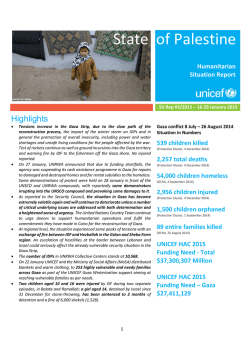
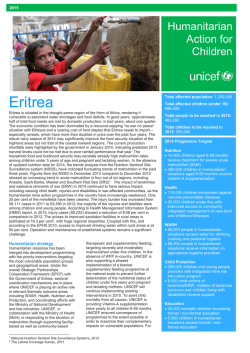
![Current appeal [PDF]](http://s2.esdocs.com/store/data/000476858_1-ff5bfc045afda14d4551c905d8c862b7-250x500.png)
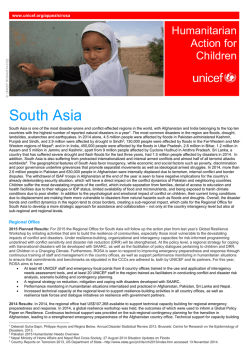
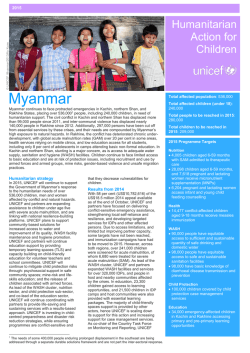
![Current appeal [PDF]](http://s2.esdocs.com/store/data/000470301_1-1a2ac0338c7b87d842a9839e11e746d1-250x500.png)
